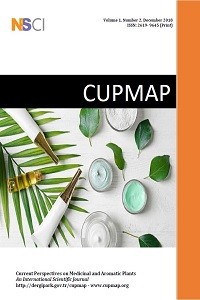Abstract
References
- 1. Republic Turkey Ministry of Health. Turkish Medicines And Medical Devices Agency Cosmetic Law, 2005, No, 25823.
- 2. Republic Turkey Ministry of Health. Turkish Medicines And Medical Devices Agency, Guidance on Microbiological Control of Cosmetic Products Version 1.0.
- 3. ISO 17516, Cosmetic microbiology microbiological limits, 2014.
- 4. ISO 21149, Cosmetic microbiology enumeration and detection of aerobic mesophilic bacteria, 2006.
- 5. ISO 16212, Cosmetic microbiology enumeration of yeast and mould, 2008.
- 6. ISO 21150, Cosmetic microbiology detection of Escherichia coli, 2006.
- 7. ISO 22717, Cosmetic microbiology detection of Pseudomonas aeruginosa, 2006.
- 8. ISO 22718, Cosmetic microbiology detection of Staphylococcus aureus, 2006.
- 9. ISO 18416, Cosmetic microbiology detection of Candida albicans, 2007.
- 10. European Pharmacopoeia 9.0, 2.6.12. Microbiological exaimination of non-sterile products: microbial enumeration tests, 2017.
- 11. European Pharmacopoeia 9.0, 2.6.13. Microbiological exaimination of non-sterile products: Test for specified micro-organisms, 2017.
Abstract
Blue and green
cosmetics are sensitive products for microbial contamination and reducing the
contamination producing according to Cosmetic Good Manufacturing Practice (ISO
22716), providing proper storage condition and packaging are effective factors. In addition
antimicrobial effective preservatives can be added to protect the cosmetic
products.1,2 Generally, preservatives are chemical substrates that
are effective on cytoplasm (conjugation mechanism, ribosomes, nucleic acids,
thiol groups, amino groups), cell wall and cytoplasm membrane (membrane
potential, enzymes, membrane penetration).3 The neutralization of
the antimicrobial effect of the preservatives in microbiological quality
control of cosmetics is essential for the safety of the tests. The
antimicrobial preservative in the cosmetic which is transferred to the medium
affects the test negatively. The neutralization process can be carried out
according to international standards used in microbiological analysis of
cosmetic products. The neutralization of preservatives in cosmetics can be
performed by adding of neutralizing agents in solvent, medium and/or washing
solution. The agents which are reacted with the preservative groups for the
removal of antimicrobial affect are used for this neutralization process which
is necessary for the removal of antimicrobial effect. According to European
Pharmacopeia 2.6.12. sodium bisulfite for glutaraldehyde and mercury compounds;
dilution for sorbates and aldehydes; lecithin, polysorbate 80, saponin for
quaternary ammonium compounds, parabens and iodines; thioglycollate for
mercurial; thiosulfate for halogens can be used as neutralizing agents.4
Lecithin, polysorbate 80 for parabens, phenoxyethanol, phenylethanol; Lecithin,
saponin, polysorbate 80, sodium dodecyl sulphate for quaternary ammonium
compounds and cationic surfactants; glycine, histidine for aldehydes
formaldehyde-release agents; sodium thiosulphate for oxidizing agents; sodium
bisulphate, L-cysteine and thioglycollic acid for metallic salts can be added
to the medium, solvent and/or washing solutions according to ISO 21149.5
For the removal of antimicrobial effect, neutralizing agents in proper
concentrations should be added to medium, solvents and washing solutions. The
addition of these agents with antimicrobial effect should be proved by the
studies of conformity. Neutralizing agents react with antimicrobial agents to
eliminate the antimicrobial effect.
References
- 1. Republic Turkey Ministry of Health. Turkish Medicines And Medical Devices Agency Cosmetic Law, 2005, No, 25823.
- 2. Republic Turkey Ministry of Health. Turkish Medicines And Medical Devices Agency, Guidance on Microbiological Control of Cosmetic Products Version 1.0.
- 3. ISO 17516, Cosmetic microbiology microbiological limits, 2014.
- 4. ISO 21149, Cosmetic microbiology enumeration and detection of aerobic mesophilic bacteria, 2006.
- 5. ISO 16212, Cosmetic microbiology enumeration of yeast and mould, 2008.
- 6. ISO 21150, Cosmetic microbiology detection of Escherichia coli, 2006.
- 7. ISO 22717, Cosmetic microbiology detection of Pseudomonas aeruginosa, 2006.
- 8. ISO 22718, Cosmetic microbiology detection of Staphylococcus aureus, 2006.
- 9. ISO 18416, Cosmetic microbiology detection of Candida albicans, 2007.
- 10. European Pharmacopoeia 9.0, 2.6.12. Microbiological exaimination of non-sterile products: microbial enumeration tests, 2017.
- 11. European Pharmacopoeia 9.0, 2.6.13. Microbiological exaimination of non-sterile products: Test for specified micro-organisms, 2017.
Details
| Primary Language | English |
|---|---|
| Journal Section | Research Articles |
| Authors | |
| Publication Date | December 31, 2018 |
| Published in Issue | Year 2018 Volume: 1 Issue: 2 |
-------------------------------------------------------------------------------------------------------------------------------













-------------------------------------------------------------------------------------------------------------------------
 CUPMAP Journal is licensed under a Creative Commons Attribution-NonCommercial-NoDerivatives 4.0 International License.
CUPMAP Journal is licensed under a Creative Commons Attribution-NonCommercial-NoDerivatives 4.0 International License.
-----------------------------------------------------------------------------------------------------------------------------------------
This is an open access journal which means that all content is freely available without charge to the user or his/her institution. Users are allowed to read, download, copy, distribute, print, search, or link to the full texts of the articles, or use them for any other lawful purpose, without asking prior permission from the publisher or the author. This is in accordance with the BOAI definition of open access.

